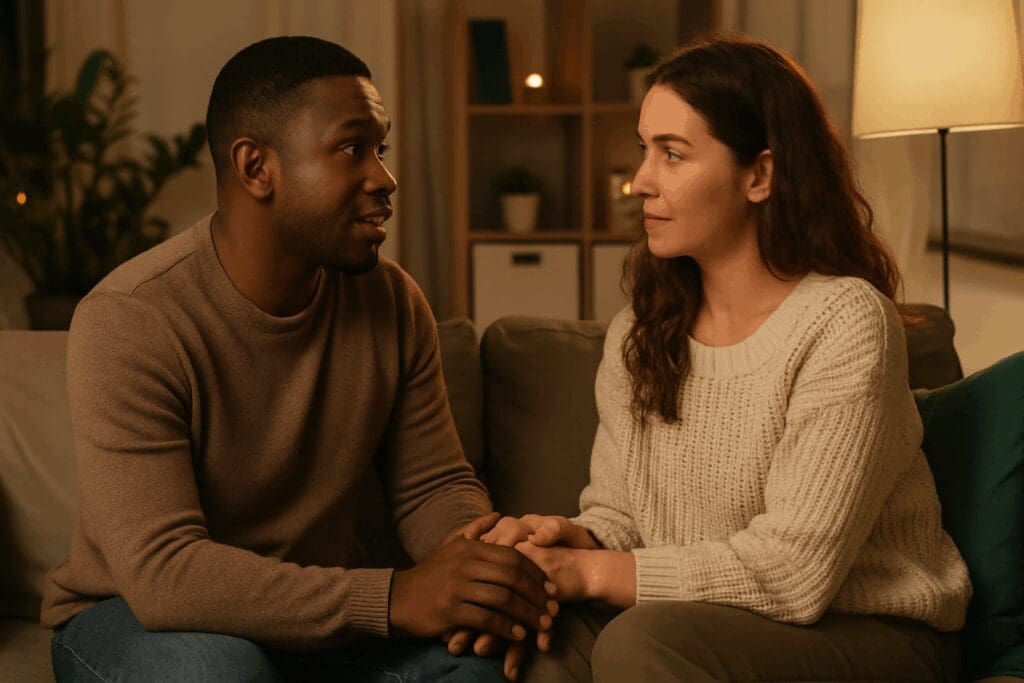The Foundation of Connection: Why Intimacy and Communication Matter
To understand how to make a relationship work, we must begin with the core pillars of human connection: intimacy and communication. While romantic partnerships often begin with passion and shared dreams, sustaining long-term fulfillment requires an ongoing, conscious investment in emotional transparency and mutual understanding. These are not static qualities but dynamic processes that evolve with time, experience, and shared vulnerability. The moment two individuals commit to navigating life together, they commit to a journey of learning—not only about each other but also about the complex emotional terrain that binds them.
A good relationship isn’t built overnight; it’s nurtured through layers of interaction, kindness, and aligned effort. Whether you’re dating, married, or in a long-term partnership, intimacy and communication form the connective tissue that holds you together during both celebration and conflict. The subtle glances across a room, the thoughtful text during a busy workday, and the hours-long late-night talks all contribute to the emotional ecosystem that keeps love alive. When these behaviors are replaced by silence, misunderstanding, or emotional distance, even the strongest attraction can falter.
This is why building a relationship must go beyond surface-level engagement. Healthy relationships are characterized by intentionality. They require a proactive stance toward listening, validating, and adapting to each other’s needs. Without open channels of communication, assumptions harden into resentment. Without intimacy, partners become strangers under the same roof. It’s not about grand gestures but about sustained, small acts of connection that signal, “I see you. I hear you. I choose you.”
Throughout this article, we will explore ten in-depth, research-informed, and emotionally intelligent strategies to foster closeness and improve relational satisfaction. These insights are not one-size-fits-all formulas; rather, they are adaptable frameworks you can personalize to suit your unique bond. By committing to these practices, you can enrich your understanding of how to have a healthy relationship while enhancing the emotional intimacy and dialogue that sustain lasting love.
You may also like: Effective Strategies for Emotional Balance: Proven Menopause Mood Swings Treatment That Works

Prioritize Emotional Safety Before Anything Else
Emotional safety is the unseen bedrock of every successful relationship. It’s the felt sense that you can express yourself without fear of judgment, retaliation, or dismissal. Before you can engage in vulnerable conversation or deepen intimacy, both partners must feel emotionally secure. This sense of safety doesn’t emerge overnight—it’s cultivated through consistent behavior, empathy, and reliability over time.
One of the essential components of emotional safety is trust—not simply the absence of betrayal but the ongoing belief that your partner has your best interests at heart. This allows both individuals to be their authentic selves without censoring their feelings. Creating this foundation means honoring emotional boundaries, respecting differing perspectives, and refusing to weaponize past vulnerabilities during conflict. When these principles are honored, intimacy grows naturally because partners know their emotional exposure won’t be used against them.
Developing emotional safety also means creating a judgment-free zone for conversations about needs, insecurities, and desires. A relationship cannot flourish if one partner feels they must hide aspects of themselves to preserve harmony. By nurturing compassion over criticism, you open the door for richer emotional exchanges and build a culture of acceptance that allows love to deepen. It’s in this environment that individuals can engage in honest dialogue about how to improve relationship dynamics without defensiveness or withdrawal.
Many wonder how to keep a relationship strong and happy over the long haul, and emotional safety is often the overlooked answer. It acts as the container within which all other forms of connection—physical, intellectual, sexual—can thrive. Establishing this kind of trust isn’t passive. It requires courage, self-reflection, and a willingness to show up for each other consistently. When partners know they can speak, cry, vent, or confess without repercussion, the relationship becomes not just a source of love, but of profound healing.

How to Make a Relationship Work Through Active Listening
The art of listening is one of the most powerful tools in creating a healthy and lasting bond. While it might sound deceptively simple, active listening is a nuanced, emotionally intelligent skill that transforms communication from transactional to transformational. In a culture where conversations are often dominated by the desire to reply, solve, or redirect, the act of truly hearing someone becomes a radical form of intimacy.
To actively listen is to tune into not just the words being spoken but the emotional tone, facial expressions, and deeper meanings behind them. It means listening without mentally formulating your response. It means pausing before you reply, paraphrasing what you’ve heard to ensure clarity, and validating the speaker’s feelings—even if you don’t agree with their interpretation of events. This non-reactive form of engagement communicates, “I care more about understanding you than winning this argument.”
Many couples in conflict aren’t fighting about facts—they’re fighting about the feeling of not being heard. When emotional needs are left unacknowledged, they often resurface through irritation, stonewalling, or passive aggression. But when individuals feel seen and understood, tensions naturally de-escalate. Active listening disarms defensiveness and builds connection even in moments of disagreement. It is the secret sauce behind how to build a healthy relationship that can withstand stress, change, and challenge.
This practice also creates space for repair. When partners feel safe enough to say, “You hurt me,” and know they will be met with attentiveness rather than argument, relational repair becomes not just possible but probable. This kind of emotional accountability can shift the trajectory of an entire relationship. In fact, many who ask “how can I better my relationship?” are often seeking these exact moments of empathic engagement.
By choosing to listen with your whole presence, you’re not only affirming your partner’s experience—you’re inviting them into a shared emotional reality where intimacy is built word by word, pause by pause.
How to Build a Good Relationship with Your Partner Through Vulnerability
Vulnerability is often mistaken for weakness, but in the context of love, it is a powerful gateway to connection. To be vulnerable is to let someone see you—truly see you—beyond your strengths and well-practiced persona. It’s the courage to say “I’m afraid,” “I need help,” or “I’m unsure of myself,” knowing full well there’s no guarantee of how that truth will be received. And yet, it’s precisely this openness that invites depth, trust, and emotional resonance.
A healthy relationship is not one where conflict never arises but one where both individuals feel safe enough to be emotionally transparent, even when the truth is messy. Whether you’re wondering how to make a relationship better or how to work on your relationship during periods of stress, practicing vulnerability can act as a reset button. It dissolves facades and reorients the focus back to authenticity.
When partners share their fears, dreams, past wounds, or unmet needs, they invite their significant other into a sacred space of inner truth. This kind of sharing cannot be coerced or rushed; it must be honored and received with tenderness. If one partner opens up and is met with criticism or indifference, that window can shut for years—or forever. Therefore, responding to vulnerability with compassion is just as important as initiating it.
Some might ask, “How can I improve my relationship with my boyfriend when he shuts down emotionally?” Often, the answer lies in modeling vulnerability first. When you reveal your inner world with sincerity and emotional responsibility—not as a weapon, but as an offering—you create an emotional blueprint that gives your partner permission to do the same. Over time, this mutual softening creates an emotional rhythm that can weather even the most intense relational storms.
Ultimately, intimacy is less about grand gestures and more about micro-moments of connection—glances, confessions, shared silences. Vulnerability is the thread that weaves those moments together into a durable emotional fabric that doesn’t unravel with tension, but grows stronger with each knot tied in trust.
How to Make a Relationship Work by Managing Conflict Constructively
One of the most revealing aspects of a relationship is not how often a couple fights, but how they fight. Conflict is inevitable, even in the healthiest relationships. But it is how partners engage during those disagreements that determines whether their connection weakens or strengthens. Learning how to make a relationship work requires reimagining conflict not as a threat, but as an opportunity for deeper understanding and emotional alignment.
Constructive conflict management starts with resisting the urge to escalate. Instead of defaulting to blame, sarcasm, or defensiveness, emotionally mature partners approach disagreements with curiosity. What is this argument really about? What need is going unmet beneath the anger? These questions invite introspection and empathy, shifting the focus from winning to resolving. Taking a moment to pause, breathe, and reflect before responding can prevent a minor irritation from becoming a relational rupture.
Setting ground rules for conflict—such as no name-calling, no interrupting, and no rehashing old grievances—can also protect the emotional safety of both partners. These agreements serve as boundaries that uphold respect even in moments of tension. They create a framework where honest communication can occur without devolving into emotional harm. This approach reflects not only how to build a good relationship with your partner, but also how to repair it when it’s been strained.
Furthermore, conflict becomes constructive when both partners take ownership of their roles. Instead of projecting blame, they say, “Here’s what I’m feeling,” or “Here’s where I went wrong.” This accountability transforms adversarial energy into partnership, making resolution possible. When apologies are sincere and paired with changed behavior, trust is rebuilt and intimacy deepens. Couples who navigate conflict in this way often report higher levels of satisfaction, even after difficult periods.
If you’ve ever wondered how to improve a relationship with your girlfriend or how to keep a relationship strong and happy, it’s important to view arguments not as failures but as feedback. Conflict is your relationship’s way of asking for attention, clarity, and care. When met with skill and compassion, it becomes a catalyst for closeness rather than disconnection.

Reignite Passion by Relearning Each Other
Over time, the initial spark in a relationship can dim—not because love has faded, but because familiarity has replaced discovery. Reigniting passion doesn’t mean replicating the honeymoon phase, but rather cultivating a sense of renewed curiosity about each other. This is where the art of relearning comes into play. When couples prioritize curiosity, they signal that their partner is not a static figure but a growing, evolving person worth rediscovering again and again.
One way to reignite passion is through intentional novelty. Trying new experiences together—whether it’s a cooking class, travel, or simply taking a walk in a new neighborhood—stimulates dopamine, the brain chemical associated with pleasure and bonding. These shared adventures create new memories, which act as emotional glue. They remind couples of their shared identity, especially when the routines of daily life threaten to reduce the relationship to logistics and obligations.
Another powerful form of rekindling passion lies in physical affection beyond sex. Holding hands, cuddling, giving each other long hugs, or massaging one another’s shoulders are simple yet profound gestures of connection. These moments activate oxytocin, also known as the “bonding hormone,” which increases trust and reduces stress. Prioritizing touch reminds both partners that attraction is not just physical—it is also emotional and spiritual.
Verbal appreciation is equally essential. Expressing admiration for your partner’s qualities, talents, or small gestures can reignite romantic energy. Often, people ask how to make a relationship better, and the answer is hidden in the language they use. Words of gratitude and affection act like emotional fertilizer, feeding the roots of the relationship with love and attention.
Ultimately, to reignite passion is to make the active choice to see your partner anew—to notice what’s changing, to celebrate their growth, and to stay engaged with their evolving dreams and fears. Passion thrives not just in the bedroom but in the eyes, the voice, and the commitment to continued emotional intimacy.
How to Build a Healthy Relationship Through Shared Vision
A common thread in enduring, fulfilling relationships is the presence of a shared vision—a set of mutually held values, goals, and dreams that act as a compass through life’s uncertainties. While love is foundational, shared vision gives that love direction. It answers the question: Where are we going together, and why? Without a shared sense of purpose, relationships can drift into disconnection or stagnation.
Developing a shared vision requires open dialogue about what truly matters to each partner. This means exploring everything from financial priorities and parenting philosophies to career ambitions and lifestyle preferences. These conversations reveal potential alignments and misalignments, which then become opportunities for negotiation and compromise. When couples actively collaborate on a shared future, they strengthen not only their plans but their bond.
Having a vision does not imply rigidity. On the contrary, flexibility is key. As circumstances change—careers shift, children grow, health fluctuates—the vision must be revisited and refined. What remains constant, however, is the sense of being on the same team. This partnership mindset is what allows couples to adapt together rather than grow apart. It is also a core element in understanding how to maintain a healthy relationship over the years.
Rituals and traditions can help ground this shared vision. Whether it’s a weekly date night, annual goal-setting conversations, or spiritual practices, these recurring moments anchor the relationship in consistency while allowing space for evolution. They also serve as reminders that the relationship itself is a living entity that deserves regular attention and care.
When both partners feel they are working toward something meaningful—whether that’s building a home, traveling the world, or creating a family—they are more likely to remain emotionally invested and resilient. A shared vision turns the relationship into a purposeful collaboration, making the trials of life more navigable and the joys more profound.
Strengthen Intimacy by Practicing Emotional Transparency
Emotional transparency is the practice of sharing one’s internal world honestly and consistently. It is the willingness to reveal your true thoughts, needs, and feelings, even when they are uncomfortable or hard to articulate. In many ways, it is the engine that drives emotional intimacy, allowing two individuals to truly know and support one another beyond surface-level interaction.
One of the biggest blocks to emotional transparency is fear—fear of judgment, rejection, or causing conflict. Yet ironically, it is the withholding of truth that causes the most relational harm. When partners edit themselves to avoid discomfort, they unintentionally create emotional distance. Over time, this can lead to a sense of isolation or misunderstanding, even within a seemingly functioning relationship.
To practice transparency effectively, it’s essential to separate emotional expression from emotional discharge. The goal is not to dump every fleeting thought or reactive feeling, but to thoughtfully share what’s most meaningful or persistent. Phrasing like, “I’m feeling distant lately and I don’t know why,” or “I need more reassurance when I’m stressed,” opens the door to mutual exploration rather than blame. This kind of dialogue is foundational to understanding how to better your relationship over time.
Transparency also means being open about your limitations. Admitting when you’re overwhelmed, uncertain, or emotionally unavailable doesn’t make you a bad partner—it makes you a human being. It gives your partner a more accurate emotional map, allowing them to respond with compassion rather than confusion. This clarity strengthens relational trust and emotional intimacy.
When emotional transparency becomes a norm, rather than a rare occurrence, the relationship transforms. Both partners feel seen in their full complexity and are more willing to offer support. It creates an environment where emotional honesty is not punished but honored, and where mutual understanding deepens with every shared truth.
How to Have a Better Relationship by Expressing Appreciation Daily
In the hustle of daily life, it’s easy to forget the small acts of care that sustain love. Yet one of the most powerful and overlooked tools for nurturing intimacy is simple, consistent appreciation. Expressing gratitude for your partner’s actions, qualities, or presence can dramatically shift the emotional tone of a relationship. It turns the mundane into the meaningful and affirms the bond in ways that words like “I love you” alone cannot.
Appreciation acts as a counterbalance to the inevitable stresses of life. When work pressures, parenting challenges, or health issues arise, relationships can easily fall into a cycle of criticism or emotional neglect. By intentionally acknowledging your partner’s efforts—whether it’s making coffee, handling a tough day with grace, or being emotionally available—you remind them that their contributions are seen and valued.
This practice doesn’t require elaborate declarations. A simple, “Thank you for listening,” or “I noticed how patient you were today,” carries tremendous weight when delivered with sincerity. These affirmations build relational equity, a reservoir of positive sentiment that helps buffer the impact of future conflicts. In fact, those searching for ways to improve a relationship often discover that appreciation is the easiest, most accessible starting point.
Appreciation also reinforces your partner’s sense of identity and self-worth within the relationship. It answers the universal question: “Do I matter to you?” When the answer is consistently yes, spoken in a thousand small ways, emotional security grows. This emotional validation not only improves day-to-day interactions but enhances long-term satisfaction and resilience.
For couples who want to understand how to improve your relationship with your boyfriend or girlfriend, daily appreciation is not just a feel-good practice—it’s a strategy backed by research. Studies consistently show that couples who express gratitude experience higher levels of satisfaction, intimacy, and emotional connection. Appreciation turns ordinary moments into opportunities for connection, deepening the relational foundation one “thank you” at a time.

How to Work on Your Relationship Through Intentional Quality Time
In the age of digital distraction and relentless busyness, one of the most profound gifts you can offer your partner is your full, undivided presence. Intentional quality time goes beyond merely being in the same room—it’s about creating moments of connection that are rich in attention, curiosity, and shared meaning. Couples who prioritize this kind of presence report stronger emotional bonds and greater satisfaction, especially during high-stress periods.
Intentional time together doesn’t need to be extravagant. What matters most is the quality of attention exchanged. Turning off devices, maintaining eye contact, asking meaningful questions, and responding with genuine interest are the markers of engaged presence. Whether you’re cooking dinner, walking the dog, or just talking on the couch, these everyday interactions become rituals of intimacy when infused with conscious attention.
Many couples wonder how to keep a relationship strong and happy over time. The answer often lies in carving out time that is sacred—protected from the demands of work, children, or screens. This could be as simple as a weekly check-in conversation or as elaborate as a planned getaway. What matters is that both partners feel prioritized and emotionally nourished.
Quality time also provides the container for other vital relational practices—conflict resolution, appreciation, sexual connection, and future planning. It allows space for vulnerability and spontaneity to emerge. By consciously slowing down and being together, couples create opportunities for emotional attunement, mutual reflection, and reconnection.
For those asking how can I make my relationship better, or how can I improve my relationship with my boyfriend or girlfriend, intentional time together offers a practical, low-barrier way to reestablish emotional closeness. When both partners consistently show up in this way, the relationship becomes a refuge—a space of calm, presence, and affection in a fast-paced world.

Strengthen Sexual Intimacy by Fostering Emotional Connection
Sexual intimacy is often viewed through the lens of physicality alone, but in thriving relationships, it is deeply intertwined with emotional closeness. When emotional connection is neglected, sexual desire tends to wane. Conversely, when partners feel emotionally bonded, sexual intimacy becomes richer, more playful, and more deeply satisfying. Understanding this interplay is crucial for anyone seeking to improve both the physical and emotional dimensions of their relationship.
Creating emotional connection before physical intimacy means cultivating trust, vulnerability, and open communication about desires and boundaries. This involves not only discussing what you want but also being attuned to your partner’s comfort and pleasure. It requires mutual curiosity and a willingness to explore—not just each other’s bodies, but each other’s emotional landscapes. When couples feel safe and emotionally connected, their physical expression of love often becomes more spontaneous and fulfilling.
Another key element is emotional foreplay—the subtle, daily interactions that build erotic tension and anticipation. These include affectionate touch, flirtatious messages, meaningful compliments, and acts of service. These gestures send the message: “I see you, I value you, I desire you,” and they lay the groundwork for more satisfying physical intimacy. They also reinforce the idea that attraction is a dynamic, evolving energy that requires care and creativity to sustain.
Healthy sexual intimacy also depends on creating a space where both partners can express their needs without shame or fear. Open communication about fantasies, insecurities, and evolving desires builds not just physical chemistry, but emotional resilience. This level of honesty is a cornerstone of how to have a healthy relationship and how to make a relationship better over time.
Ultimately, sexual intimacy thrives in a relational culture of emotional generosity, shared playfulness, and deep mutual respect. When emotional and physical intimacy are nurtured together, they become self-reinforcing, forming a loop of connection that infuses every aspect of the relationship with vitality and affection.

Cultivate Resilience Together During Life Transitions
Every relationship will face seasons of change—some joyful, like the birth of a child or a career milestone, and others more challenging, like illness, grief, or financial hardship. How couples navigate these transitions often determines the long-term strength and stability of the relationship. Building relational resilience means learning how to bend without breaking, how to support one another without losing oneself, and how to emerge stronger on the other side of adversity.
Resilience begins with a shared commitment to facing change as a team. This means checking in regularly about how each person is coping, what support they need, and how roles might shift in response to new circumstances. These conversations promote clarity, reduce resentment, and foster a sense of solidarity. They are also a vital tool for those wondering how can I better my relationship or how can I improve relationship dynamics during stressful periods.
Emotional flexibility is another key trait of resilient couples. Rather than insisting on rigid expectations or roles, they adapt in response to life’s demands. For example, when one partner experiences burnout, the other may step up to provide more emotional or logistical support. These temporary adjustments are not signs of imbalance, but expressions of relational generosity and care.
Resilient couples also have rituals that sustain them during hard times—whether it’s a shared mantra, a spiritual practice, or simply holding hands in silence. These grounding practices reinforce the connection even when words fail. They serve as a reminder that even in uncertainty, the relationship remains a source of strength and safety.
For those exploring how to work on your relationship during upheaval, resilience isn’t about suppressing difficulty—it’s about leaning into it together. It’s about saying, “This is hard, but I’m here. We’ll figure it out.” In doing so, couples transform life’s challenges into catalysts for deeper trust, empathy, and growth.
What Makes a Good Relationship Endure Over Time
After years together, many couples ask the same timeless question: What makes a good relationship last? The answer is multifaceted, but it often comes down to three core ingredients: emotional availability, mutual respect, and continuous growth. These are not one-time accomplishments, but ongoing practices that evolve as the relationship deepens.
Emotional availability means being consistently open and responsive to your partner’s emotional needs. It requires presence during joy and during sorrow, a willingness to sit with discomfort, and the humility to admit when you’ve caused harm. This kind of availability builds deep-rooted trust and serves as the anchor during turbulent times.
Mutual respect, meanwhile, forms the ethical backbone of a relationship. It involves honoring each other’s individuality, celebrating differences, and never resorting to contempt, manipulation, or disrespectful behavior—even in conflict. It’s the daily practice of treating your partner not just with love, but with dignity.
Continuous growth is the third pillar. Relationships that thrive over decades are those where both partners remain curious—about each other, about themselves, and about how to make a relationship work better over time. They invest in self-awareness, seek out new experiences, and engage in regular reflection about the health of their bond. They view the relationship not as a finished product, but as a living ecosystem that needs nourishment and adaptation.
Ultimately, what makes a good relationship is not perfection, but commitment—to listening, to growing, to returning to love again and again, even when it’s hard. It’s the choice to be better, not just for your partner, but for the relationship you are both creating together.
Frequently Asked Questions: How to Make a Relationship Work and Keep It Thriving
1. How can shared challenges strengthen a relationship in the long run?
Facing challenges together can be one of the most powerful ways of building a relationship that endures. Shared adversity—whether it’s navigating financial struggles, coping with grief, or enduring long-distance—can foster resilience and deeper emotional intimacy. These experiences often push couples to develop stronger communication patterns and clarify their values as a unit. Rather than viewing hardship as a threat, seeing it as a collaborative mission helps reinforce the idea that you’re a team. In fact, many couples report that weathering difficult times together taught them not just how to make a relationship work, but also how to keep a relationship strong and happy over the years.
2. What role does personal growth play in making a relationship work?
A surprisingly overlooked aspect of making a relationship work is the emphasis on individual growth. When each partner pursues their own goals, passions, and emotional development, it contributes to a more fulfilling and dynamic partnership. This doesn’t mean growing apart; rather, it means bringing a continually evolving self to the relationship. In healthy relationships, personal evolution can become a shared value, prompting mutual inspiration. One of the most impactful healthy relationship tips is to nurture your individuality so that your connection thrives—not just survives.
3. How does understanding each other’s love languages improve connection?
Understanding love languages is foundational for those asking, “how can I better my relationship?” or “how can I improve my relationship with my boyfriend or girlfriend?” When couples express affection in the ways their partner naturally receives it—whether through words of affirmation, acts of service, quality time, physical touch, or gifts—they communicate love more clearly. It eliminates misinterpretations and unmet expectations, which often cause tension. Practicing this skill consistently is one of the most effective ways to better your relationship. When both partners feel seen and valued in the language they understand best, they are far more likely to say the relationship feels like a safe, affirming space.
4. What’s the impact of curiosity on how to build a good relationship with your partner?
Curiosity keeps relationships fresh and connected. Continually asking your partner thoughtful questions—even after years together—helps uncover new layers of personality, values, and dreams. This doesn’t mean prying, but engaging from a place of genuine interest. People change over time, and sustaining curiosity is key for those wondering how to build a good relationship with your partner in the long term. The couples who keep learning about each other tend to also know how to have a better relationship that evolves with time.
5. How can rituals enhance emotional intimacy?
Couples who develop personal rituals—such as morning coffee together, weekly date nights, or bedtime check-ins—create consistent anchors of connection. These rituals don’t need to be elaborate to be powerful. They offer predictability and comfort, especially during chaotic life seasons. For those looking for how to maintain a healthy relationship, nurturing these micro-moments of closeness can be a game changer. It’s a small but significant way of showing up regularly, reinforcing the bond even during stress or disconnection.
6. Why is repair after conflict more important than never fighting?
Disagreements are inevitable, but what determines a good relationship isn’t the absence of conflict—it’s how repair is handled. Making a relationship work requires learning how to listen non-defensively, validate your partner’s feelings, and apologize sincerely. These skills create a culture of emotional safety. If you’re wondering how to improve relationship dynamics, focus less on being “right” and more on being connected. Mastering repair techniques is one of the best ways to improve your relationship and build long-term emotional security.
7. What boundaries are essential for how to make a relationship work?
Boundaries protect emotional energy, foster mutual respect, and clarify each person’s needs. They might include designated alone time, limits around family interference, or how finances are managed. For anyone exploring how to work on your relationship, learning to both set and respect boundaries is a must. Healthy boundaries don’t create distance—they actually build trust. When you honor your partner’s personal space, you foster the conditions necessary for building a relationship where both people thrive independently and together.
8. How do shared visions contribute to how to build a healthy relationship?
A couple with a shared vision has a deeper sense of purpose and direction. Whether it’s planning future travels, parenting strategies, or financial goals, shared long-term plans create unity and reduce the potential for conflict. Understanding what makes a good relationship often starts with aligning on where you’re headed and why. People who regularly discuss goals tend to have healthier conflict resolution and greater satisfaction. Vision-building is essential for those wondering how to make a relationship better and turn good into great.
9. What are the less obvious ways to improve emotional intimacy?
Subtle cues like checking in during the day, using inside jokes, or offering physical affection at unexpected times can dramatically improve emotional closeness. Emotional intimacy thrives not just through deep conversations but through these light, connective gestures. If you’re asking how to have a healthy relationship or how can I make my relationship better, consider these small acts as essential emotional deposits. Over time, they create a rich, resilient foundation of love and care. Such consistent emotional investments are often the quiet force behind making a relationship work.
10. How can learning styles affect relationship communication?
Couples rarely consider how their individual learning styles affect how they process communication. Some people absorb information better visually, others through written notes or spoken discussion. Misalignment here can create repeated misunderstandings. Being aware of this helps personalize how you express appreciation, feedback, or concern. For those asking how to improve your relationship with boyfriend or girlfriend, adjusting communication methods based on how they learn and retain information is an advanced but powerful strategy. This shift can enhance both everyday connection and the resolution of deeper conflicts, supporting healthier relationships long-term.
Embracing the Journey: How to Make a Relationship Work for the Long Haul
Making a relationship work isn’t about checking boxes or adhering to a one-size-fits-all formula. It’s about embracing a living, evolving connection that demands care, courage, and consistency. When we talk about how to make a relationship work, we’re really talking about how to show up—day after day, moment after moment—with intentionality, honesty, and love. This is not a passive process. It is an active commitment to understanding, to forgiving, to growing both individually and together.
Each of the ten strategies explored in this article—emotional safety, active listening, vulnerability, conflict management, reigniting passion, shared vision, emotional transparency, daily appreciation, quality time, and resilience—offers a distinct yet interconnected pathway to deeper intimacy and communication. These practices are not theoretical ideals but lived experiences, cultivated through deliberate effort and reinforced through repetition. They are the everyday choices that build a life of shared meaning.
For those wondering how can I improve my relationship or how to better your relationship in practical ways, it’s important to begin with a mindset of partnership rather than perfection. Challenges are inevitable, but they are not insurmountable when both individuals are willing to learn and grow. A good relationship isn’t the result of never having problems—it’s the result of navigating them with empathy, openness, and the shared desire to stay connected even through discomfort.
Sustaining a healthy relationship over time also requires the courage to evolve. As individuals change—and they will—so too must the relationship. This means continuously asking: What do we need now? What’s working? What needs to shift? These questions keep the relationship dynamic and responsive rather than static and stale. They also remind both partners that love is a verb, not a noun—a practice rather than a possession.
At its heart, learning how to build a healthy relationship is about cultivating a relational ecosystem in which both people can thrive. It’s about turning toward each other, again and again, in celebration, in crisis, and in the quiet in-between. When partners commit to this ongoing process, they not only create a strong and happy relationship—they create a haven, a home, and a legacy of love that endures.
Further Reading:
10 Ways YOU Can Build a Healthy Relationship



